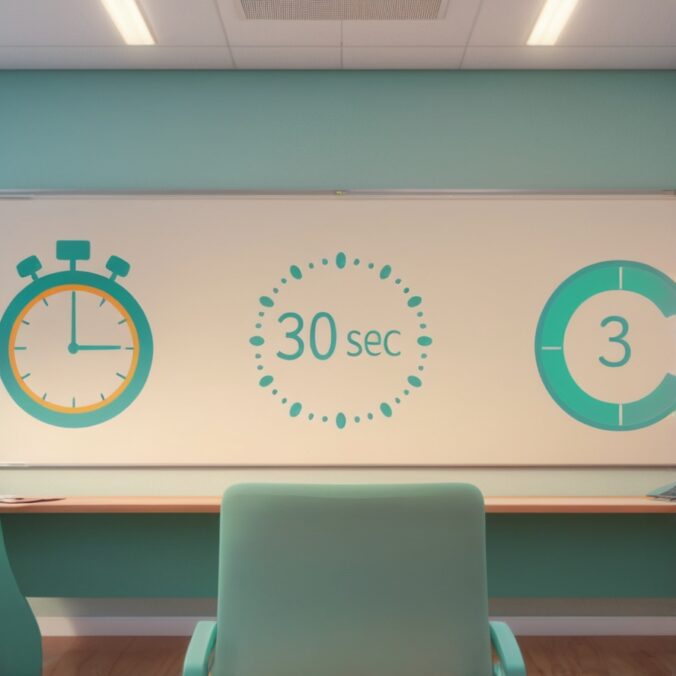I use Leonardo.ai as my go-to image generator, and recently their Senior Creative Technologist published a 27-page paper on “vibe marketing.” As a technology partner for creatives, when Leonardo publishes something that in-depth, it is worth paying attention. Seeing it explored at that level of detail piqued my interest and pushed me to dive deeper into the idea.
Continue readingCategory: Content Strategy
Hook (3 seconds)
Most product messages fail because they start at the end. They lead with facts before earning the right to be heard. But people need something to grab their attention first.
Tease (30 seconds)
That’s why I work with something I call the 3-30-3 Rule. It isn’t a formula carved in stone, but a useful guide. The premise is simple:
Continue readingEarly in my career, I was a tactician. Email campaigns, SEO, SEM, building landing pages, hacking together A/B tests. Whatever the job needed, I’d figure it out.
Then I got older. Took on bigger roles. Strategy became my thing. I got an MBA, which basically teaches you how to never do real work again. Just make PowerPoints and use fancy terms like “ubiquitous” and “leveraging synergies.” Just kidding. Kind of.
Then I taught at UW. Strategy-heavy, theory-driven. But not much time for learning how to troubleshoot a broken Meta ad pixel or chase down why TikTok didn’t like the file format you uploaded.
Fast-forward to a recent client gig. A small, scrappy brand with big potential. I figured with AI at my side, I could go back to being a full-stack marketer. The headlines promised that AI was like hiring a 12-person team. All I had to do was show up and prompt. Well, that’s what I thought would happen…
Continue readingDoes the 3-30-3 Writing Framework Still Work?
There is a writing model I’ve followed for years. I swear I stole it from someone else, but whenever I try to find the article that taught it to me, I can’t locate it. Maybe I dreamed it. Maybe it was a late night conversation at Ad Club.
Regardless, the idea is simple:
- You get 3 seconds to grab someone’s attention and earn 30 more seconds.
- You have that 30 seconds to earn their interest and earn 3 more minutes.
- Only then, in that 3 minutes, do you get to earn enough trust to shift their mindset, earn a response, or close the deal.
So, does it still work today?
Read more: Does the 3-30-3 Writing Framework Still Work?1. 3 seconds to stop the scroll
The Nielsen Norman Group says most users decide whether to stay or leave a page within 10 to 20 seconds. But if you can keep them for the first 5 seconds, the odds of them staying longer go up significantly.
Mobile is even less forgiving. A Meta study found people make up their mind about content in just 1.7 seconds while scrolling. First impressions matter. A lot.
2. 30 seconds to hook curiosity
The average reader doesn’t get far. According to Chartbeat, more than half of visitors spend less than 15 seconds actively reading a piece of content. But if someone makes it to 30 seconds, their chances of continuing to the 1-minute mark nearly double.
That’s where interest turns into attention.
3. 3 minutes to actually do something
If someone spends 3 minutes or more with your content, they’re in it. A Nielsen study showed that readers who stay that long are more likely to subscribe, share, or convert. Heatmaps from Crazy Egg show that serious purchase intent tends to happen after the 2-minute mark, when people have read enough to feel confident.
So yes, the 3-30-3 model still works.
It lines up with how attention works in real life. People make fast decisions, scan quickly for value, and only commit when they feel something is worth it. If you can clear those three checkpoints of attention, interest, evaluation in one piece of content, you’re doing more than getting clicks. You’re actually getting through.
As companies (like my clients) finalize their 2025 marketing strategies, many are asking whether LinkedIn still warrants a dedicated line in the budget. Once a critical space for B2B visibility and thought leadership, the platform now faces new competition, rising costs, and declining returns for some sectors. Plus, it seems like hardly anyone actually works there.
It seems like for every reason to keep it, there’s an equally valid one for abandoning it.
Read more: Does LinkedIn Still Belong in 2025 Marketing Budgets?Engagement Is Still Strong—But Flattening
For B2B marketers, LinkedIn has historically been unmatched in terms of audience intent. But engagement metrics suggest the platform may be nearing a plateau. According to LinkedIn’s own Benchmark Report, click-through rates on thought leadership posts declined year over year:
- 2023: 0.55%
- 2024: 0.49%
Meanwhile, a June 2024 Socialinsider study found carousel posts remained the most engaging format, especially for professional services firms. Short videos, once seen as a growth area, now underperform outside of HR or recruitment content.
The Cost Equation Is Shifting
Advertising on LinkedIn remains expensive—often prohibitively so for performance marketers. Wordstream’s Q3 2024 report shows stark differences in average CPM:
- LinkedIn: $38.12
- Meta (Facebook/Instagram): $14.74
- TikTok: $8.91
For campaigns focused on lead generation or direct conversions, the ROI may be difficult to justify compared to cheaper alternatives.
When LinkedIn Still Delivers
Despite those challenges, LinkedIn still drives value for certain brands—particularly those with high-ticket offerings or a professional audience. Sectors continuing to see returns include:
- SaaS and enterprise software
- Management consulting
- HR technology and recruiting firms
- Financial services
- Executive coaching and leadership training
These industries benefit from the trust and credibility that LinkedIn still holds with decision-makers.
For Consumer Brands, Less Justifiable
For lifestyle or direct-to-consumer brands, LinkedIn rarely makes sense. The professional context limits emotional storytelling, and users are less receptive to brand content unless it’s tied to employment, entrepreneurship, or career development.
Even brands experimenting with employer branding and culture posts are seeing limited traction unless the content is truly unique or backed by a hiring initiative.
A Tighter, Smarter Approach
LinkedIn isn’t dead, it just isn’t automatic. Marketers should reevaluate its role based on goals, cost, and audience fit. For brands that use it well, the platform can still offer high-quality engagement. For others, 2025 may be the right year to scale back and reinvest in channels with broader reach and better value.
I know you’re going to hate hearing this. I hate writing it. But if your brand still isn’t on TikTok as 2023 wraps up, you may be behind. This isn’t trend-chasing. We have to suck it up and go where attention lives. TikTok is shaping buying decisions across nearly every demographic, not just Gen Z.
1. People Are Spending Serious Time Here
TikTok now has over 1 billion monthly active users, and the average person spends about 95 minutes per day on the app. That’s more screen time than Netflix for some people (Saintnicks). And it’s not background noise. People are watching closely, not just scrolling past.
2. The Algorithm Works in Your Favor
You don’t need a huge follower count. TikTok’s algorithm recommends content based on what people like to watch, not who they follow. That gives smaller brands a legit shot to go big—even from zero. (Wikipedia – TikTok)
3. Low Budget, High Impact
You don’t need fancy gear or a studio. TikTok rewards authenticity. A founder talking to their phone camera can outperform a polished brand ad—if the message hits home (Third Wunder).
4. It’s Already Working for Small Businesses
This isn’t theory. One small brand boosted revenue by 1,650% after going viral on TikTok (Business Insider). TikTok itself reported $24.2 billion in economic activity from small businesses using the platform in 2023 (TikTok Newsroom).
5. TikTok Shop Removes Friction
Launched in September, TikTok Shop lets you sell right inside the app. No redirecting people to your website. No friction. You see it, you click it, you buy it (Wikipedia – TikTok Shop).
6. People Trust What They See
A TikTok study found that 92% of users who took action after watching a video said they did it because the content made them feel something. And 72% said they trust TikTok creators more than traditional ads (TikTok “What’s Next” report).
The Takeaway
TikTok isn’t just silly videos anymore. Used effectively, it can be a source of leads.





